Magnolia × soulangeana
Magnolia × soulangeana, the saucer magnolia, is a hybrid plant in the genus Magnolia and family Magnoliaceae. It is a deciduous tree with large, early-blooming flowers in various shades of white, pink, and purple. It is one of the most commonly used magnolias in horticulture, being widely planted in the British Isles, especially in the south of England; and in the United States, especially the east and west coasts.[2]
| Magnolia × soulangeana | |
|---|---|
.jpg) Flowering branches | |
| Hybrid parentage | Magnolia denudata × Magnolia liliiflora |
| Cultivar | Magnolia × soulangeana Thiéb.-Bern.[1] |
| Origin | Fromont, near Paris, France |
Hybrid origin
Magnolia × soulangeana was initially bred by French plantsman Étienne Soulange-Bodin (1774–1846), a retired cavalry officer in Napoleon's army, at his château de Fromont near Paris. He crossed Magnolia denudata with M. liliiflora in 1820, and was impressed with the resulting progeny's first precocious flowering in 1826.[3][4]
From France, the hybrid quickly entered cultivation in England and other parts of Europe, and also North America. Since then, plant breeders in many countries have continued to develop this plant, and over a hundred named horticultural varieties (cultivars) are now known.[2]
Description
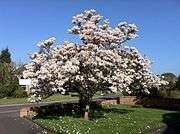
.jpg)
Growing as a multistemmed large shrub or small tree, Magnolia × soulangeana has alternate, simple, shiny, dark green oval-shaped leaves on stout stems. Its flowers emerge dramatically on a bare tree in early spring, with the deciduous leaves expanding shortly thereafter, lasting through summer until autumn.[2]
Magnolia × soulangeana flowers are large, commonly 10–20 cm (4–8 in) across, and colored various shades of white, pink, and maroon. An American variety, 'Grace McDade' from Alabama, is reported to bear the largest flowers, with a 35 cm (14 in) diameter, white tinged with pinkish-purple.[2] Another variety, Magnolia × soulangeana 'Jurmag1', is supposed to have the darkest and tightest flowers. The exact timing and length of flowering varies between named varieties, as does the shape of the flower. Some are globular, others a cup-and-saucer shape.
Cultivation
Magnolia × soulangeana is notable for its ease of cultivation, and its relative tolerance to wind and alkaline soils (two vulnerabilities of many other magnolias). The cultivar 'Brozzonii' has gained the Royal Horticultural Society's Award of Garden Merit.[5]
Gallery
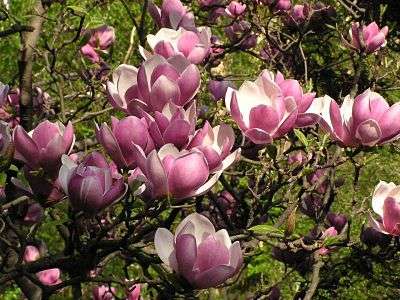 Magnolia × soulangeana, with large, showy flowers opening before the leaves.
Magnolia × soulangeana, with large, showy flowers opening before the leaves.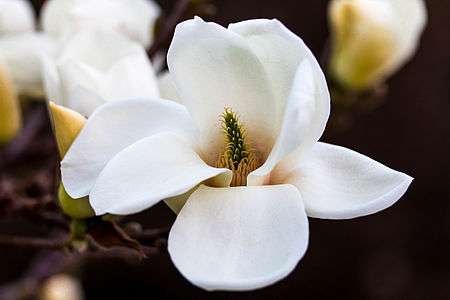 A white bud of a Magnolia × soulangeana
A white bud of a Magnolia × soulangeana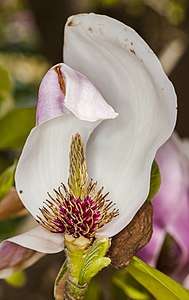 Detail of a Magnolia × soulangeana 'Speciosa'.
Detail of a Magnolia × soulangeana 'Speciosa'.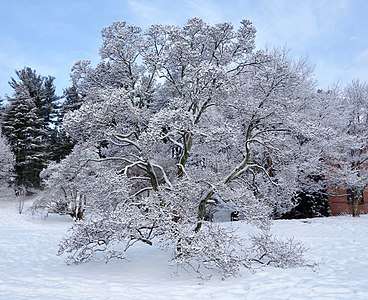 Magnolia x soulangeana ‘Candolleana’, 1895 accession, Arnold Arboretum of Harvard University
Magnolia x soulangeana ‘Candolleana’, 1895 accession, Arnold Arboretum of Harvard University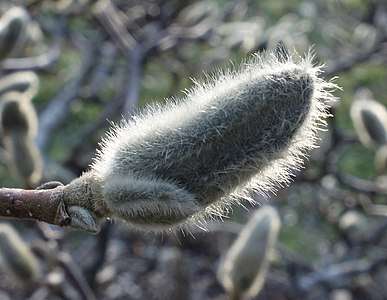 Flower bud
Flower bud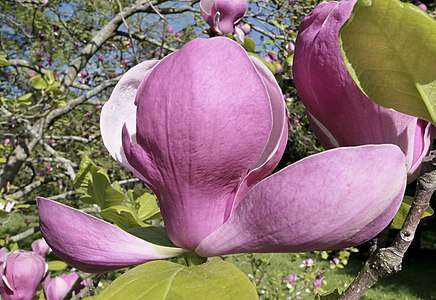 Magnolia x soulangeana ‘Andre Leroy’ flower.
Magnolia x soulangeana ‘Andre Leroy’ flower.
References
- Many times, Soulange-Bodin is cited as the author of this hybrid name, rarely with a reference to a publication however. If a source is given, it is often an English translation of a French title (see for example Callaway, D.J. (1994), World of Magnolias: 204). Soulange-Bodin certainly did not name the hybrid after himself. The name was proposed by members of the Société Linnéenne de Paris and published by Arsène Thiébaud de Berneaud, the secretary of the society, in Relation de la cinquième fête champêtre célébré le 24 mai 1826 in: Comte-Rendu des Travaux de la Société Linnéenne de Paris 1826: 269.
- Gardiner, Jim (2000). Magnolias: A Gardener's Guide. Portland, Oregon: Timber Press. pp. 265–80. ISBN 0-88192-446-6.
- Soulange-Bodin, E. (1826), Notice sur une nouvelle espèce de magnolia in: Bulletin des Sciences Agricoles et Économique, Tome VI, (Paris): 57
- In Mémoires de la Société Linnéenne de Paris, vol. 5 (1827): lxxiii Thiébaut de Bernaud gives a reference (in note 2) to the first publication of the name and the description, in Relation de la fête champêtre du 24 mai 1826.
- "Magnolia × soulangeana 'Brozzonii' AGM". Royal Horticultural Society. 2017. Retrieved 2017-01-27.